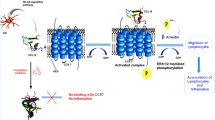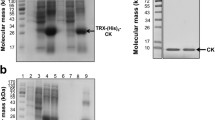Abstract
Antagonism of CCR9 is a promising mechanism for treatment of inflammatory bowel disease, including ulcerative colitis and Crohn’s disease. There is limited experimental data on CCR9 and its ligands, complicating efforts to identify new small molecule antagonists. We present here results of a successful virtual screening and rational hit-to-lead campaign that led to the discovery and initial optimization of novel CCR9 antagonists. This work uses a novel data fusion strategy to integrate the output of multiple computational tools, such as 2D similarity search, shape similarity, pharmacophore searching, and molecular docking, as well as the identification and incorporation of privileged chemokine fragments. The application of various ranking strategies, which combined consensus and parallel selection methods to achieve a balance of enrichment and novelty, resulted in 198 virtual screening hits in total, with an overall hit rate of 18%. Several hits were developed into early leads through targeted synthesis and purchase of analogs.






Similar content being viewed by others
Notes
A crystal structure of the CCR9 receptor was reported in 2016 after we finished our virtual screening campaign [5].
Abbreviations
- CCR9:
-
CC Chemokine receptor 9
- CCL25:
-
CC Chemokine ligand 25
- GPCR:
-
G-Protein coupled receptor
- HTS:
-
High-throughput screen
- LE:
-
Ligand efficiency
- PCA:
-
Principal component analysis
- SAR:
-
Structure–activity relationship
References
Papadakis KA, Prehn J, Moreno ST et al (2001) CCR-9 positive lymphocytes and thymus-expressed chemokine distinguish small bowel from colonic Crohn’s disease. Gastroenterology 121:246–254
Walters MJ, Wang Y, Lai N, Baumgart T, Zhao BN, Dairaghi DJ, Bekker P, Ertl LS, Penfold ME, Jaen JC, Keshav S, Wendt E, Pennell A, Ungashe S, Wei Z, Wright JJ, Schall TJ (2010) Characterization of CCX282-B, an orally bioavailable antagonist of the CCR9 chemokine receptor, for treatment of inflammatory bowel disease. J Pharmacol Exp Ther 335:61–69
Bertus E, David H, Adams (2010) GSK-1605786, a selective small-molecule antagonist of the CCR9 chemokine receptor for the treatment of Crohn’s disease. IDrugs 13(7):472–481 (Thomson Reuters)
Choi WT (2012) J. Drug discovery research targeting the CXC chemokine receptor 4 (CXCR4). J Med Chem 55:977–994
Oswald C et al (2016) Intracellular allosteric antagonism of the CCR9 receptor. Nature 540:462–465
Mantovani A (1999) The chemokine system: redundancy for robust outputs. Immunol Today 20:254–257
Brunner PM, Glitzner E, Reininger B et al (2015) CCL7 contributes to the TNF-alpha-dependent inflammation of lesional psoriatic skin. Exp Dermatol 24:522–528
Allen SJ, Crown SE, Handel TM (2007) Chemokine: receptor structure, interactions, and antagonism. Annu Rev Immunol 25:787–820
Murphy PM, Baggiolini M, Charo IF, Hébert CA, Horuk R, Matsushima K, Miller LH, Oppenheim JJ, Power CA (2000) International Union of Pharmacology. XXII. Nomenclature for chemokine receptors. Pharmacol Rev 52:145–176
Ungashe S, Wei Z, Basak A, Charvat T, Jin J, Moore J, Zang Y, Punna S, Dairaghi D, Hansen D, Pennell A (2006) Heteroaryl Sulfonamides and CCR2. U.S. Patent 20060173019 A1, 3 August 2006
James Pease; Richard Horuk Chemokine Receptor Antagonists (2012) J Med Chem 55(22):9363–9392
Baba M, Takashima K, Miyake H, Kanzaki N, Teshima K, Wang X, Shiraishi M, Iizawa Y (2005) TAK-652 inhibits CCR5-mediated human immunodeficiency virus type 1 infection in vitro and has favorable pharmacokinetics in humans. Antimicrob Agents Chemother 49:4584–4591
Evans BE, Rittle KE, Bock MG, DiPardo RM, Freidinger RM, Whitter WL, Lundell GF, Veber DF, Anderson PS, Chang RSL, Lotti VJ, Cerino DJ, Chen TB, Kling PJ, Kunkel KA, Springer JP, Hirshfieldt J (1988) Methods for drug discovery: development of potent, selective, orally effective cholecystokinin antagonists. J Med Chem 31:2235
Patchett AA, Nargund RP (2000) Privileged structures—an update. Annu Rep Med Chem 35:289–298
Zhang J et al (2015) Biarylsulfonamide CCR9 inhibitors for inflammatory bowel disease. Bioorg Med Chem Lett 25:3661–3664
Willett P (2013) Combination of similarity rankings using data fusion. J Chem Inf Model 53:1–10
Tan L, Geppert H, Sisay MT, Gütschow M, Bajorath J (2008) Integrating structure- and ligand-based virtual screening: comparison of individual, parallel, and fused molecular docking and similarity search calculations on multiple targets. ChemMedChem 3:1566–1571
ChEMBL; ChEMBL database version 13. https://www.ebi.ac.uk/chembl/. Accessed 18 June 2012
GVK Biosciences; GOSTAR Online Structure Activity Relationship Database. https://gostardb.com/gostar/. Accessed 5 July 2012
Lewell XQ, Judd DB, Watson SP, Hann MM (1998) RECAP-retrosynthetic combinatorial analysis procedure: a powerful new technique for identifying privileged molecular fragments with useful applications in combinatorial chemistry. J Chem Inf Comput Sci 38:511–522
Bemis GW, Murcko MA (1996) The properties of known drugs. 1. Molecular frameworks. J Med Chem 39:2887–2893
Rogers D, Hahn M (2010) Extended-connectivity fingerprints. J Chem Inf Model 50:742–754
Hu Y, Lounkine E, Bajorath J (2009) Improving the search performance of extended connectivity fingerprints through activity-oriented feature filtering and application of a bit-density-dependent similarity function. ChemMedChem 4:540–548
Willet P (2006) Similarity-based virtual screening using 2D fingerprints. Drug Discov Today 11(23/24):1046–1053
Hawkins PCD, Skillman AG, Warren GL, Ellingson BA, Stahl MT (2010) Conformer generation with OMEGA: algorithm and validation using high quality structures from the protein databank and Cambridge structural database. J Chem Inf Model 50:572–584
Hawkins PCD, Skillman AG, Nicholls A (2007) Comparison of shape-matching and docking as virtual screening tools. J Med Chem 50:74–82
Shao Y et al (2006) Advances in methods and algorithms in a modern quantum chemistry program package. Phys Chem Chem Phys 8:3172–3191
Molecular Operating Environment (MOE) Chemical Computing Group Inc., 1010 Sherbrooke St. West, Suite #910. Montreal, QC, Canada H3A 2R7
Wu B et al (2010) Structures of the CXCR4 chemokine GPCR with small-molecule and cyclic peptide antagonists. Science 330:1066–1071
Ballesteros JA, Weinstein H (1995) Integrated methods for the construction of three-dimensional models and computational probing of structure-function relations in G protein-coupled receptors. Methods Neurosci 25:366–428
Prioleau C, Visiers I, Ebersole BJ, Weinstein H, Sealfon SC (2002) Conserved Helix 7 tyrosine acts as a multistate conformational switch in the 5HT2C receptor identification of a novel “locked-on” phenotype and double revertant mutations. J Biol Chem 277:36577–36584
Courcot B, Bridgeman AJ (2011) Modeling the interactions between polyoxometalates and their environment. J Comp Chem 32:3143–3153
Kobilka BK, Deupi X (2007) Conformational complexity of G-protein-coupled receptors. Trends Pharmacol Sci 28:397–406
Heifetz A et al (2015) GPCR structure, function, drug discovery and crystallography: Report from Academia-Industry International Conference (UK Royal Society) Chicheley Hall, 1–2 September 2014 Naunyn-Schmiedeberg’s archives of pharmacology
Heifetz A, Barker O, Morris GB, Law RJ, Slack M, Biggin PC (2013) Toward an understanding of agonist binding to human Orexin-1 and Orexin-2 receptors with G-protein-coupled receptor modeling and site-directed mutagenesis. Biochemistry 52:8246–8260
Xue C et al (2011) Discovery of INCB8761/PF-4136309, a potent, selective, and orally bioavailable CCR2 antagonist. ACS Med Chem Lett 2(12):913–918
Beuming et al (2015) Docking and virtual screening strategies for GPCR drug discovery. Methods Mol Biol 1335:251–276
Kooistra et al (2016) Function-specific virtual screening for GPCR ligands using a combined scoring method. Sci Rep 6:28288
Acknowledgements
The authors thank Rory Curtis for biology leadership, Evotec for development and execution of the high-throughput screen, and MultiSpan for running the primary calcium FLIPR assay.
Author information
Authors and Affiliations
Corresponding author
Electronic supplementary material
Below is the link to the electronic supplementary material. Assay conditions, structures of reference compounds, and details of computational methods.
Rights and permissions
About this article
Cite this article
Zhang, X., Cross, J.B., Romero, J. et al. In-silico guided discovery of novel CCR9 antagonists. J Comput Aided Mol Des 32, 573–582 (2018). https://doi.org/10.1007/s10822-018-0113-2
Received:
Accepted:
Published:
Issue Date:
DOI: https://doi.org/10.1007/s10822-018-0113-2




